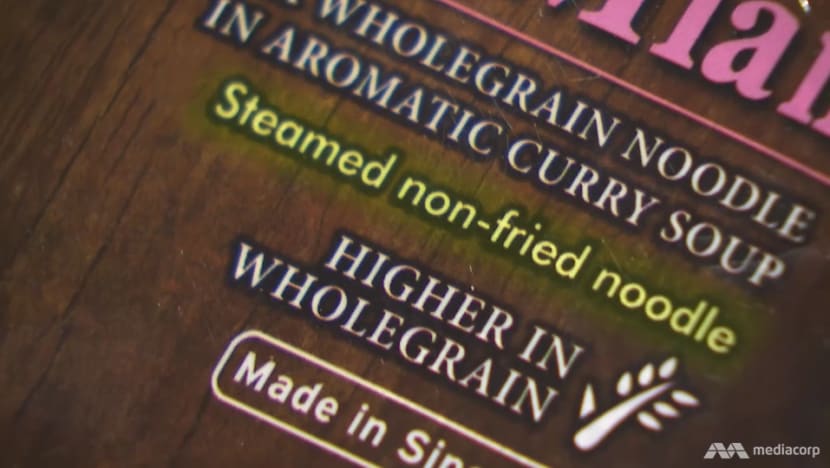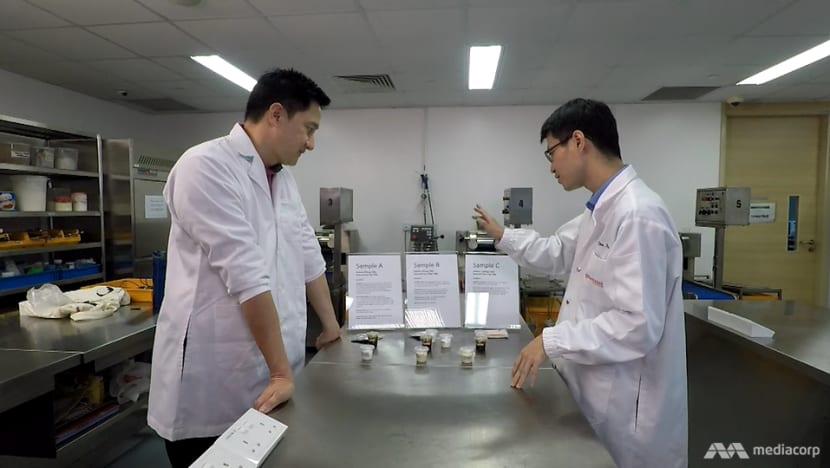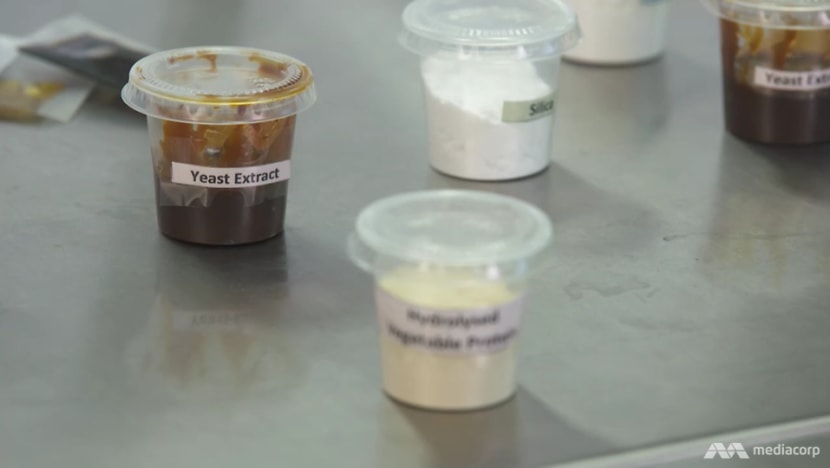Are healthier instant noodles really healthy? After the hype come the checks
The healthier versions of this traditional favourite have gained in popularity among consumers in Singapore. But are these alternatives just marketing gimmicks? The programme Talking Point investigates.

A serving of regular instant noodles surrounded by healthier versions.
SINGAPORE: As comfort food to many Singaporeans, instant noodles tide us over on time-starved days and overtime shifts, and double up as a late-night indulgence.
Apart from the convenience, many people return to their favourite brand for its flavour. Instant noodle fans know they are not eating these quick-fix meals to reap health benefits.
In an online Nielsen poll in July, 49 per cent of the 201 respondents said they eat instant noodles for the “yummy/delicious” taste, while 35 per cent considered instant noodles to be their “comfort food”.
Only 24 per cent eat instant noodles for the healthier versions.

Yet, these healthier varieties have gained in popularity, with sales increasing by about 35 per cent in the first six months of this year, compared to the same period last year, noted Singapore’s largest supermarket chain, FairPrice.
Amid the growing demand, the question remains: Are they really healthy and all they are cut out to be? The programme Talking Point finds out four things about healthier instant noodles and whether these justify jumping on the bandwagon. (Watch the episode here.)
1. WHAT’S THE HYPE?
First, healthier instant noodles are typically marketed as “non-fried”.
Prima Taste, for example, has produced air-dried wholegrain instant noodles since 2015. Wholegrains have been known to reduce stroke, the risk of high cholesterol and the risk of heart disease, says assistant general manager Melvin Tjahaja.
“There’s no added oil in the cooking process or in the drying process. As a result of that, our noodles have very low fat content — less than two per cent,” he adds.
“From what I know, regular instant noodles, which have gone through the flash-frying process, contain 15 to 20 per cent of fat.”

There are also baked and air-dried noodles.
2. THE INGREDIENTS CHANGE, BUT THERE’S STILL WHEAT FLOUR
Regular instant noodles are made of refined wheat, which is known to be stripped of nutrients like fibre and minerals. That is why some manufacturers might opt for raw materials other than wheat for instant noodles.
But some non-wheat varieties are not exactly free of refined wheat, as explained by chef and food writer Sarah Benjamin Huang.
First, Bambara groundnut noodles: They contain twice as much protein as typical instant noodles and are loaded with fibre, which makes for a healthy gut. One also feels fuller for longer after eating these noodles.

Second, moringa leaves noodles: These are packed with two to three times more fibre than regular wheat instant noodles.
These two instant noodles seem healthier, but the catch is that they are not 100 per cent made up of nuts or leaves. Those ingredients come in around fourth on the list, says Huang.
The thing that makes noodles and pasta “really chewy” is wheat flour.
“You need the gluten from the wheat flour to hold the noodles together,” she adds. “You do have to have that as the main component if you want that familiar slurpy texture.”

Third, aloe vera noodles: They still contain a regular amount of wheat, except aloe vera is used to replace water in the manufacturing process.
This makes these noodles healthier by increasing the amount of potassium, which works in tandem with sodium to control blood pressure.
Finally, konjac noodles: These shirataki-based noodles are Japanese noodles made from konjac yam and are low in carbohydrates and calories. Unlike the previous three examples, konjac noodles do not contain wheat.
Huang says 100 grammes of regular instant noodles contain about 60g of carbohydrates and 400 calories. Konjac noodles, however, contain only 1g of carbohydrates and around 15 calories for every 100g of noodles.

This is “almost a negligible amount of carbs, so these are perfect for anyone who’s on a low-carb diet for medical reasons, or if you’re doing (the) keto (diet), which is very popular these days”, she adds.
Konjac noodles also contain a soluble fibre called glucomannan, which helps to reduce the risk of heart disease.
As healthy as these alternative versions might be, Huang maintains that as a chef, “taste is number one”.
“If these healthier options don’t taste as good, they don’t feel as good texture-wise, then it’s not going to scratch the itch of the occasional instant noodle craving,” she says.
3. THE DEVIL IS IN THE SEASONING
The stuff that gets people hooked, however, is not actually the noodles. “The soup or the sauces are the more sinful part. The noodles are just noodles,” says Ramen Lab chef consultant Jason Lim.
WATCH: Are ‘healthier’ instant noodles really better for you? (2:45)
But how does the seasoning in healthier instant noodles compare with regular ones?
“Air-dried noodles are healthier than fried noodles in terms of the noodles itself, because they have a much lower amount of fat. But that doesn’t mean their seasoning is healthier,” says Temasek Polytechnic food science and nutrition lecturer Guo Ren.
The trick is to look at the sodium content on the packaging, he adds, citing the three instant noodle seasoning samples brought in by Talking Point.
Sample A, from fried noodles, contained 873mg of sodium per 100g. Samples B and C, from air-dried noodles, contained 742mg and 1,300mg respectively, proving that the method of cooking the noodles is unrelated to the sodium level in the seasoning.

“What does it mean? It could mean the manufacturer is trying to compensate for the lack of oil and frying,” he says. “Air-dried is nowhere near fried noodles in terms of the flavour fullness. So some would put more sodium.”
Eliminating MSG in particular does not necessarily mean healthier either, as manufacturers may add other flavourings.
“For example, things like hydrolysed vegetable protein and yeast extract. Now these are natural flavourings, but they impart that umami flavour, that ... savoury flavour,” dietician Jaclyn Reutens tells Talking Point in a separate interview.
“Things like inosinate and guanylate, which are artificial flavourings, also impart that umami flavour. But they’re also really high in sodium.”
To decrease their sodium intake, consumers could use half a packet of seasoning or make their own seasoning or broth for their noodles.

Otherwise, one could look out for instant noodles with less than 400mg of sodium per 100g, or less than 8g of saturated fat per 100g.
4. HEALTHIER NOODLES COST MORE
Then there is the camp who turns to instant noodles because of affordability. In the Nielsen poll, 45 per cent of respondents said they eat instant noodles for this reason.
Healthier instant noodles, however, tend to be more expensive. In the long run, these few dollars and cents add up. And these noodles are not necessary, especially if one is strapped for cash, Reutens told CNA Insider.
Although they are low in calories and high in fibre, which is why they are considered healthier, one can get fibre from fruits and vegetables. One can also eat less for a lower calorie intake.

“Instant noodles are the carb portion of a meal. (You) can get the same nutrients in normal white rice. You can buy dried bee hoon or wholemeal bee hoon, which is so much cheaper. That’ll give you carbs as well as fibre,” says Reutens.
Health food marketing, she notes, tends to focus on quinoa and organic foods, which are relatively expensive.
“But you can also eat healthily on much more affordable options. I’ve seen wholemeal bee hoon selling at the same price as normal, white bee hoon. Yoghurt is cheaper than ice cream. Low-fat milk is sometimes cheaper than almond milk,” she says.
“The common misconception is that healthy foods are tasteless and more expensive. But you don’t have to spend a lot if you know how to do it.”
Where marketing gimmicks are concerned, the dehydrated corn and vegetable garnishes typically present in instant noodle seasonings are for “visual appeal”, adds Reutens. “They don’t increase the nutritional value very much because the dehydration strips away their nutrients.”
Watch this episode of Talking Point here. New episodes on Channel 5 every Thursday at 9.30pm.


















